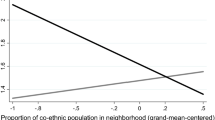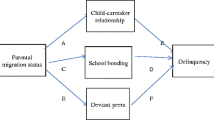Abstract
Using the panel samples from the Los Angeles Family and Neighborhood Survey (L.A. FANS), this paper examined the associations of extended household structures—the entry, stay, and exit of grandparents (vertical kin) and other extended adults (horizontal kin)—with child behavioral problems across US-born, documented and undocumented Latinx families. Difference-score regression models showed differential associations of extended kin by different types of transitions. For children of US-born Latina mothers, gaining grandparents was associated with higher (worse) levels of internalizing (i.e. withdrawn) behaviors, whereas losing grandparents was associated with lower (better) levels of internalizing and externalizing (i.e. disobedient) behaviors. For children of documented Latina mothers, gaining grandparents had no effect, but losing grandparents and keeping horizontal kin were associated with lower levels of internalizing behaviors. For children of undocumented Latina mothers, gaining grandparents was associated with higher levels of externalizing behaviors, but keeping grandparents was associated with lower levels of internalizing behaviors, and keeping horizontal kin was associated with lower levels of both internalizing and externalizing behaviors. The association between the household transition of extended kin and children’s behavior reflects selection rather than causation in the context of family life course and US immigration policy.
Similar content being viewed by others
References
Blank, S. (1998). Hearth and home: The living arrangements of Mexican immigrants and U. S.-Born Mexican Americans. Sociological Forum, 13(1), 35–59.
Blank, S., & Torrecilha, R. S. (1998). Understanding the living arrangements of Latino immigrants: A life course approach. The International Migration Review, 32(1), 3–19.
Brabeck, K. M., & Sibley, E. (2016). Immigrant parent legal status, parent–child relationships, and child social emotional wellbeing: A middle childhood perspective. Journal of Child and Family Studies, 25(4), 1155–1167.
Burnette, D. (1997). Grandparents raising grandchildren in the inner city. Families in Society: The Journal of Contemporary Social Services, 78(5), 489–501.
Castro-Schilo, L., & Grimm, K. J. (2018). Using residualized change versus difference scores for longitudinal research. Journal of Social and Personal Relationships, 35(1), 32–58.
Chavez, L. R. (1990). Coresidence and resistance: Strategies for survival among undocumented Mexicans and central Americans in the United States. Urban Anthropology and Studies of Cultural Systems and World Economic Development, 19(1/2), 31–61.
Chavez, L. R. (2012). Shadowed lives: Undocumented immigrants in American society. Fort Worth: Cengage Learning. https://www.worldcat.org/title/shadowed-lives-undocumented-immigrants-in-american-society/oclc/804497222
Chen, F., Mair, C. A., Bao, L., & Yang, Y. C. (2015). Race/ethnic differentials in the health consequences of caring for grandchildren for grandparents. The Journals of Gerontology Series B: Psychological Sciences and Social Sciences, 70(5), 793–803.
Child Trends. (2018). Immigrant Children—Child Trends. https://www.childtrends.org/indicators/immigrant-children
Cross, C. J. (2018). Extended family households among children in the United States: Differences by race/ethnicity and socio-economic status. Population Studies, 72(2), 235–251. https://doi.org/10.1080/00324728.2018.1468476
Degboe, A., BeLue, R., & Hillemeier, M. (2011). Parental immigrant status and adolescent mental health in the United States: Do racial/ethnic differences exist? Child and Adolescent Mental Health, 17(4), 209–215.
DeLeire, T., & Kalil, A. (2002). Good things come in threes: Single-parent multigenerational family structure and adolescent adjustment. Demography, 39(2), 393–413.
Dunifon, R., & Kowaleski-Jones, L. (2007). The influence of grandparents in single-mother families. Journal of Marriage and Family, 69(2), 465–481.
Elder, G. H. (1998). The life course as developmental theory. Child Development, 69(1), 1–12.
Elder, G. H., Johnson, M. K., & Crosnoe, R. (2003). The emergence and development of life course theory. In J. T. Mortimer & M. J. Shanahan (Eds.), Handbook of the life course (pp. 3–19). Boston, MA: Springer.
Enchautegui, M. E., & Menjívar, C. (2015). Paradoxes of family immigration policy: Separation, reorganization, and reunification of families under current immigration Laws. Law & Policy, 37(1–2), 32–60.
Fanti, K. A., & Henrich, C. C. (2010). Trajectories of pure and co-occurring internalizing and externalizing problems from age 2 to age 12: Findings from the National Institute of Child Health and Human Development study of early child care. Developmental Psychology, 46(5), 1159–1175.
Fomby, P., & Estacion, A. (2011). Cohabitation and Children’s Externalizing Behavior in Low-Income Latino Families. Journal of Marriage and the Family, 73(1), 46–66. https://doi.org/10.1111/j.1741-3737.2010.00788.x
Fuller-Thomson, E., & Minkler, M. (2007). Central American grandparents raising grandchildren. Hispanic Journal of Behavioral Sciences, 29(1), 5–18.
Gilbertson, G., & Gurak, D. T. (1992). Household transitions in the migrations of Dominicans and Colombians to New York. The International Migration Review, 26(1), 22–45.
Glick, J. E. (1999). Economic support from and to extended kin: A comparison of Mexican Americans and Mexican immigrants. The International Migration Review, 33(3), 745–765.
Glick, J. E., Bean, F. D., & Van Hook, J. (1997). Immigration and changing patterns of extended family household structure in the United States: 1970–1990. Journal of Marriage and the Family, 59, 177–191.
Gomberg-Muñoz, R. (2015). The punishment/El Castigo: Undocumented Latinos and US immigration processing. Journal of Ethnic & Migration Studies, 41(14), 2235–2252.
Gonzales, R. G. (2016). Lives in limbo undocumented and coming of age in America. Oakland: University of California Press.
Gubernskaya, Z., & Tang, Z. (2017). Just like in their home country? A multinational perspective on living arrangements of older immigrants in the United States. Demography, 54(5), 1973–1998.
Guttmannova, K., Szanyi, J. M., & Cali, P. W. (2008). Internalizing and externalizing behavior problem scores: Cross-ethnic and longitudinal measurement invariance of the behavior problem index. Educational and Psychological Measurement, 68(4), 676–694.
Hagan, J., Eschbach, K., & Rodriguez, N. (2008). U.S. deportation policy, family separation, and circular migration. The International Migration Review, 42(1), 64–88.
Hall, M., Musick, K., & Yi, Y. (2019). Living arrangements and household complexity among undocumented immigrants—Hall—2019—Population and development review—Wiley online library. Population and Development Review, 45(1), 81–101.
Hamilton, H. A. (2005). Extended families and adolescent well-being. Journal of Adolescent Health, 36(3), 260–266.
Hao, L., & Woo, H. S. (2012). Distinct trajectories in the transition to adulthood: Are children of immigrants advantaged? Child Development, 83(5), 1623–1639.
Hernandez, D. J. (2004). Demographic change and the life circumstances of immigrant families. The Future of Children, 14(2), 17–47.
Hogan, D. P., Eggebeen, D. J., & Clogg, C. C. (1993). The structure of intergenerational exchanges in American families. American Journal of Sociology, 98(6), 1428–1458.
Hondagneu-Sotelo, P. (1994). Gendered transitions: Mexican experiences of immigration. Berkeley: University of California Press.
Jacobsen, L. A., Mather, M., & Dupuis, G. (2012). Household change in the United States (Vol. 67). Washington, DC: Population Reference Bureau.
Kana’iaupuni, S. M., Donato, K. M., Thompson-Colón, T., & Stainback, M. (2005). Counting on kin: Social networks, social support, and child health status. Social Forces, 83(3), 1137–1164.
Kang, J., & Cohen, P. N. (2017). Extended kin and children’s behavioral functioning: Family structure and parental immigrant status. Social Science & Medicine, 186, 61–69.
Kao, G., & Tienda, M. (1995). Optimism and Achievement: The Educational Performance of Immigrant Youth. Social Science Quarterly, 76(1), 1–19
Landale, N. S., Hardie, J. H., Oropesa, R. S., & Hillemeier, M. M. (2015). Behavioral functioning among Mexican-origin children does parental legal status matter? Journal of Health and Social Behavior, 56(1), 2–18.
Landale, N. S., Thomas, K. J. A., & Van Hook, J. (2011). The living arrangements of children of immigrants. Future of Children, 21, 43–70.
Massey, D. S., & Gentsch, K. (2014). Undocumented migration to the United States and the wages of Mexican immigrants. International Migration Review, 48(2), 482–499.
Menjívar, C. (2006). Liminal legality: Salvadoran and Guatemalan immigrants’ lives in the United States 1. American Journal of Sociology, 111(4), 999–1037.
Mollborn, S., Fomby, P., & Dennis, J. A. (2011). Who matters for Children’s early development? Race/ethnicity and extended household structures in the United States. Child Indicators Research, 4(3), 389–411.
Mollborn, S., Fomby, P., & Dennis, J. A. (2012). Extended household transitions, race/ethnicity, and early childhood cognitive outcomes. Social Science Research, 41(5), 1152–1165.
Monserud, M. A., & Elder, G. H., Jr. (2011). Household Structure and Children’s Educational Attainment: A Perspective on Coresidence with Grandparents. Journal of Marriage and Family, 73, 981–1000.
Oldehinkel, A. J., Hartman, C. A., De Winter, A. F., Veenstra, R., & Ormel, J. (2004). Temperament profiles associated with internalizing and externalizing problems in preadolescence. Development and Psychopathology, 16(02), 421–440.
Passel, J. S., Cohn, D., & Gramlich, J. (2018). U.S. births to unauthorized immigrants have fallen since 2007. Pew Research Center. https://www.pewresearch.org/fact-tank/2018/11/01/the-number-of-u-s-born-babies-with-unauthorized-immigrant-parents-has-fallen-since-2007/
Passel, J. S., & Cohn, D. (2019). Mexicans decline to less than half the U.S. unauthorized immigrant population for the first time. Pew Research Center. https://www.pewresearch.org/fact-tank/2019/06/12/us-unauthorized-immigrant-population-2017/
Perle, J. G., Levine, A. B., Odland, A. P., Ketterer, J. L., Cannon, M. A., & Marker, C. D. (2013). The association between internalizing symptomology and risky behaviors. Journal of Child & Adolescent Substance Abuse, 22(1), 1–24.
Pessar, P. R. (1982). The role of households in international migration and the case of U.S. – Bound migration from the Dominican Republic. The International Migration Review, 16(2), 342–364.
Peterson, J. L., & Zill, N. (1986). Marital disruption, parent-child relationships, and behavior problems in children. Journal of Marriage and Family, 48(2), 295–307.
Pittman, L. D., & Boswell, M. K. (2008). Low-income multigenerational households: Variation in family functioning by mothers’ age and race/ethnicity. Journal of Family Issues, 29(7), 851–881.
Portes, A. (1995). The economic sociology of immigration : Essays on networks, ethnicity, and entrepreneurship. New York: Russell Sage Foundation.
Rodriguez, N. P. (1987). Undocumented central Americans in Houston: Diverse populations. The International Migration Review, 21(1), 4–26.
Smokowski, P. R., Rose, R. A., & Bacallao, M. (2010). Influence of risk factors and cultural assets on Latino adolescents’ trajectories of self-esteem and internalizing symptoms. Child Psychiatry & Human Development, 41(2), 133–155.
Van Hook, J., & Glick, J. E. (2007). Immigration and living arrangements: Moving beyond economic need versus acculturation. Demography, 44(2), 225–249.
Yoshikawa, H. (2011). Immigrants raising citizens: Undocumented parents and their young children. New York: Russell Sage Foundation.
Author information
Authors and Affiliations
Corresponding author
Additional information
Publisher’s Note
Springer Nature remains neutral with regard to jurisdictional claims in published maps and institutional affiliations.
Appendix
Appendix
Rights and permissions
About this article
Cite this article
Kang, J., Cohen, P.N. & Chen, F. Latinx Families’ Extended Household Structures and Child Behavioral Problems across Mother’s Immigrant Status in Los Angeles. Child Ind Res 14, 95–116 (2021). https://doi.org/10.1007/s12187-020-09749-1
Accepted:
Published:
Issue Date:
DOI: https://doi.org/10.1007/s12187-020-09749-1




